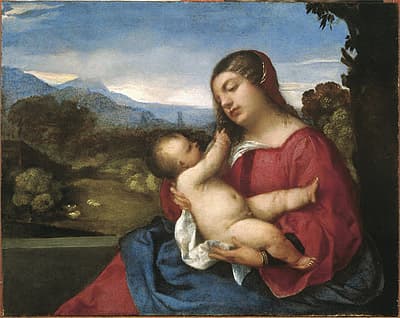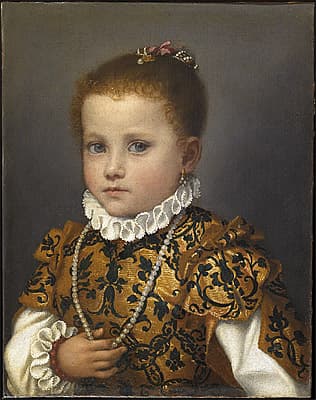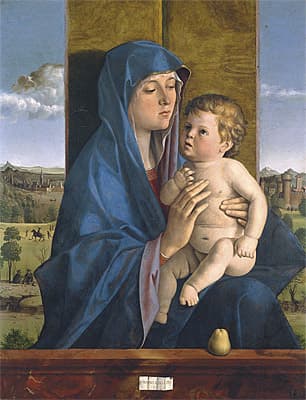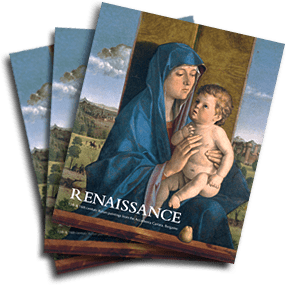The exhibition
For the first time the National Gallery of Australia will give visitors the opportunity to experience Early and High Renaissance paintings by many of the greatest Italian artists. Raphael, Sandro Botticelli, Giovanni Bellini and Titian are some of the painters represented in our summer exhibition, which reveals an amazing gamut of talent and creative splendour. More than 70 works on canvas and wood panel will be on display only in Canberra.
These treasures are on loan from the Accademia Carrara in Bergamo, Italy. Borrowing from its marvellous collection is only possible because the Accademia is renovating its display spaces, and the museum is temporarily closed.
The works in Renaissance were created between 1400 and 1600 by exceptional artists in northern and central Italy. Of extraordinary quality, the paintings were made in such centres of Renaissance culture as Venice, Florence, Milan, Bergamo, Padua, Ferrara and Siena, where the Church and private patrons commissioned religious scenes as well as magnificent portraits. Subjects range from poignant depictions of the Madonna and Child, Bible stories, the lives of the saints and moving renditions of the Crucifixion to insightful images of nobles and patricians.
These two centuries of Italian art are the foundation of the grand tradition of European painting. The genius of Raphael and Titian is known to all, but less famous artists such as Cosmè Tura, Carlo Crivelli, Lorenzo Lotto, Bartolomeo Vivarini, Vittore Carpaccio, Pietro Perugino and Giovan Battista Moroni announce their prodigious talents in Canberra. Paintings by Raphael, Botticelli, Bellini, Andrea Mantegna and Perugino have never been shown in Australia before; other works, painted by some of the most important and talented artists to practise in this formative period of European art, have rarely or never been shown here.
In Crivelli’s Madonna and Child 1475, an ornately dressed Mary is crowned the Queen of Heaven. She holds her Son protectively with elegant hands, her head tilted to Him as He nestles into her. The panel is shaped in graceful curved arches, reminding us of the earlier sources of Renaissance art, while beautifully executed fruit and a carnation symbolise elements of the Christian story. The landscape setting repays close attention, contrasting a verdant scene with a harsh one. Crivelli worked in the Marches of central Italy, away from the then modern cultural centres, so his art retains Gothic decorative features such as the relief on the Virgin’s clothes.
Lorenzo Costa’s Saint John the evangelist c 1480 was originally painted in tempera on wood panel and later transferred to canvas. His use of bright, clear colour enlivens the portrayal of the saint, who holds his attributes of the palm frond of martyrdom and chalice. The dead tree and live cypresses represent death and eternal life, while a severe marble structure locates the apostle’s life in the Roman Empire. Costa demonstrates his knowledge and love of classical architecture while providing a counterpoint to the lush folds of fabric.
 Titian 'Madonna and Child in a landscape' c 1507 oil on wood panel 38.8 x 48.3 cm Accademia Carrara, Bergamo
Titian 'Madonna and Child in a landscape' c 1507 oil on wood panel 38.8 x 48.3 cm Accademia Carrara, BergamoRenaissance Europe saw bursts of invention and new technology, from the development of telescopes to the introduction of oil paint. The medium spread into Italy from Flanders in the second half of the fifteenth century, and its brilliant hues and depth came to its apogee in Venice in the sixteenth century. One of the earliest masters was Bellini, whose Madonna and Child 1488 shows a mother looking tenderly at her baby Son. Her deep-blue drapery dominates the image. The Christ Child stands on a marble ledge upon which rests a pear. Bellini proudly signs his work on a cartellino (small piece of paper) painted onto the canvas.
The Florentine artist Botticelli created The story of Virginia the Roman 1498 as a large panel. He narrates the tragedy of a young girl whose death saves the Roman republic. Reading from the left, Virginia’s fate unfolds: the assault on her virtue, trial by her kidnapper, murder at the hands of her father and her posthumous vindication. Botticelli presents the theatrical scene in three acts, rich in colour and rhythmic in movement, and set within grand Classical architecture. Saint Sebastian 1501–02 is depicted by Raphael holding an arrow, which would become the instrument used by his torturers. Instead of the traditional iconography of a partially draped man shown full length, the artist presents an elegant and richly dressed young man wearing gold-embroidered black brocade, a red cloak with gold edging and a gold chain. Raphael enjoys pictorial devices such as the saint’s oval face mirrored in the loop of his chain, the curved halo echoed in his eyebrows. Again, the early Christian subject is placed in an idyllic central Italian landscape of the Renaissance.
 Sandro Botticelli 'Christ the Redeemer blessing' 1500–15 tempera on panel 47.6 x 32.3 cm Accademia Carrara, Bergamo
Sandro Botticelli 'Christ the Redeemer blessing' 1500–15 tempera on panel 47.6 x 32.3 cm Accademia Carrara, BergamoAmong other exquisite images of the Madonna and Child is Titian’s canvas of about 1507, resplendent in colour, sensuous in its rendering of flesh and drapery and set in the countryside surrounding Venice. Such depictions of local scenery, bringing the sacred stories home to their audiences, signal the birth of landscape painting. The naturalism of the scene is underlined by the warm rapport of mother and baby, totally absorbed in each other.
 Giovan Battista Moroni 'Girl from the Redetti family' 1566–70 oil on canvas 43 x 33 cm Accademia Carrara, Bergamo
Giovan Battista Moroni 'Girl from the Redetti family' 1566–70 oil on canvas 43 x 33 cm Accademia Carrara, BergamoThe most charming portrait in the exhibition is Moroni’s Girl from the Redetti family 1566–70. She is dressed in her best clothes and jewellery, holding her pearl necklace in one hand and wearing a coral bracelet to protect her health. The artist captures the little girl’s patience, as it is about to turn to weariness with the hard task of sitting for her portrait. His rendering of the gold-and-black silk dress is a tour de force of oil painting.
The National Gallery of Australia is delighted to show great art from the Italian Renaissance. The exhibition will enrich the cultural life of Australia and reinforce our already warm bonds of friendship with the people of Italy, who have generously agreed to share their wonderful paintings with us.
Christine Dixon
Senior Curator, International Painting and Sculpture

Exhibition catalogue
This beautifully designed and lavishly illustrated exhibition catalogue is a great addition to any art lover’s collection. Read more
$39.95 special NGA shop price



